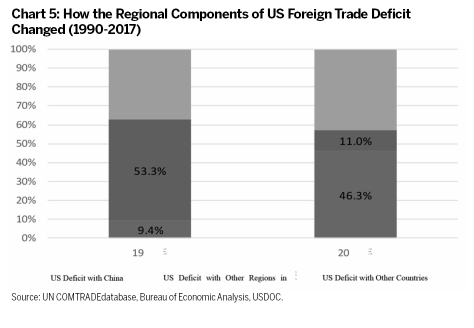The facts and China's position on China-US trade friction
China Daily | Updated: 2018-09-26 08:00

Fourth, this is the consequence of US export control over high-tech products exported to China. The US boasts huge competitive strength in high-tech trade. Yet, haunted by the cold-war mentality, it imposes strict export controls on China, thereby limiting the potential of advantageous US exports, causing significant lost export opportunities, and widening its trade deficit with China. According to a report by the Carnegie Endowment for International Peace in April 201713, if US export controls on China were relaxed to the level of those on Brazil, its deficit could be cut by 24%, and 35% if relaxed to the level of France. Evidently there remains a huge potential to be tapped in high-tech exports to China. If the US had not itself closed the door, it could well have seen its trade deficit reduced.
Fifth, this is the result of the US dollar being a major global currency. The Bretton Woods system established after WWII was based on the US dollar. On the one hand, the US uses its "exorbitant privilege"14 to levy seignorage on all countries. For the US the cost for printing a hundred-dollar bill is no more than a few cents, but other countries will have to provide real goods and services in exchange for that note. On the other hand, as a major global currency, the US dollar supports global trade settlements, and the US supplies US dollars to the world by way of a deficit. Therefore, beneath the US trade deficit lie profound US interests and the very root of the international currency system.
In addition, US statistics exaggerate its deficit in trade in goods with China. There has been a significant and long-standing statistical divergence between China and the US. In 2017, Chinese statistics recorded a Chinese surplus of US$275.8 billion, while US statistics showed it to be US$395.8 billion, a gap of about US$100 billion. The statistical working group comprising experts from the USDOC and MOFCOM compare every year the statistics from China and the US, and estimate that the US statistics overstate the trade deficit with China by 20% every year. According to statistics from China Customs and the USDOC, the dynamics of and gap between the two statistics have been largely the same over the past decade. (Chart 6) Causes for divergence include differences between CIF and FOB prices, transit trade value-added, direct trade markup, geographical jurisdiction, and shipping time delay.

If calculated by value added, the deficit would decrease significantly. China's foreign trade is characterized by large-scale imports and large-scale exports in processing, which applies to its trade with the US as well. According to MOFCOM, by trade methods, 61% of the China-US trade imbalance comes from processing. The value added in China accounts for only a small portion of the total value of many products, while the current approach is to calculate an export by aggregate (total value of goods exported). The WTO and the OECD started to advocate in 2011 a global perspective on production, and proposed to analyze the roles and benefits of all countries participating in the global distribution of labor by the approach of value-added accounting, for which the database WIOD was established. As an example, in 2016 conventional statistics show China's surplus with the US to be US$250.7 billion. Based on the WIOD database and using the value-added approach, this would become US$139.4 billion, a 44.4% decrease from the aggregate approach.
























